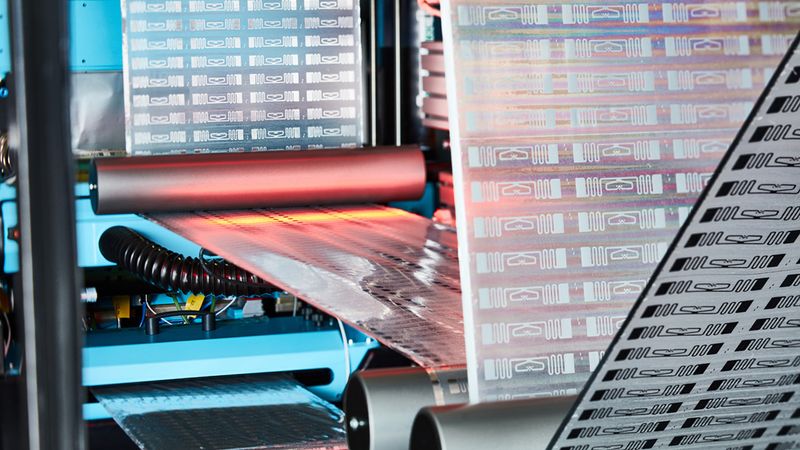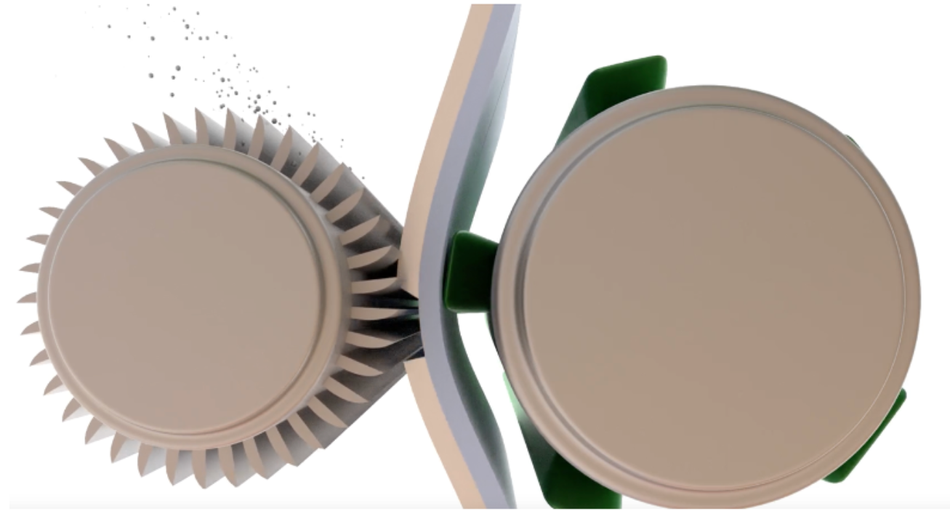Dry Phase Patterning: A Next-Generation Alternative to Silver Printing in Electronics
Discover how Dry Phase Patterning offers a faster, greener, and cheaper alternative to silver inks in flexible electronics and printed circuit boards.

Image: Production of RFID Antennas using Dry Phase Patterning technology. Source: DPPatterning
Introduction
Silver inks have long been a key player in the field of printed electronics, especially for applications requiring flexible circuits, like wearable sensors and electrodes, but also for applications like antennas, heaters, pressure sensors, etc. These inks, which contain finely dispersed silver particles, were once prized for their relatively high conductivity and oxidation resistance compared to other printable materials. Their ability to create thin, conductive traces on substrates like plastic and paper unlocked numerous applications, from smart labels to touchscreens1. Over the past decade, silver-based printed electronics have grown into a multi-billion dollar industry2.
Today, however, the reliance on silver is being re-evaluated. Manufacturers face fluctuating prices, uncertainties– from cost and supply risks to environmental and performance concerns. Silver is expensive and subject to price volatility, it entails intensive mining and chemical processing, and printed silver traces have known drawbacks with conductivity. These challenges have driven the search for alternatives.
In fact, these issues were already recognized by the industry in the late 1990s, prompting the launch of a research initiative at RISE (Research Institutes of Sweden). After years of research and industry collaboration, a promising solution was commercialized: Dry Phase Patterning (DPP). This novel manufacturing method eliminates the need for silver inks. Instead, it uses a mechanical milling process to rapidly pattern common metals like aluminum, offering a faster, cheaper, and greener path to flexible electronics. Today, Dry Phase Patterning is the base for the Swedish deeptech company DP Patterning AB, which revolutionizes the existing Flex-PCB market with their disruptive technology for Flex-PCB production.
This article explores how Dry Phase Patterning works and why it is emerging as a next-generation alternative to silver printing.
Comparing Aluminum vs. Silver Printing
Silver’s traditional advantages come with significant downsides in the current landscape, especially when comparing against aluminum flex-pcbs produced with the Dry Phase Patterning process:
- High Cost and Price Volatility vs. Low and Stable Prices: Silver is a precious metal with an exceptionally volatile price. Geopolitical tensions, investor speculation, and supply‑chain disruptions—such as labor strikes at major mines or export restrictions—regularly trigger price swings of 10–20 % within weeks. This volatility makes budgeting for silver‑based inks unpredictable and can sharply inflate product costs. By contrast, aluminum is extremely inexpensive and trades in a much deeper, more diversified market; roughly 300 kg of aluminum costs about the same as 1 kg of silver, highlighting the magnitude of the price gap2. The relative stability of aluminum prices therefore provides manufacturers with a far more predictable cost base.
- Process and Performance Limitations: Silver ink printing involves multiple steps (printing, drying, sintering) and often relies on chemical solvents, which add complexity. Moreover, the cured ink is a porous composite that reaches only about 10–30 % of bulk‑silver conductivity. A solid‑metal aluminium trace produced by DPP therefore achieves roughly 2 to 3 times higher electrical conductivity than an equivalently sized printed‑silver trace. Printed silver lines can also suffer reliability issues—for instance, they may tarnish or form conductive dendrites in humid conditions if not encapsulated (Perelaer et al., Adv. Funct. Mater. 2010). By contrast, aluminium forms a thin, self‑limiting oxide layer that protects the conductor without meaningfully degrading its performance.
What is Dry Phase Patterning?
Dry Phase Patterning is a mechanical milling manufacturing method that produces flexible circuits without any liquid inks or chemical etching. Instead of printing conductive material, DPP starts with a flex laminate, (a thin foil of metal, usually aluminum, laminated on a flexible substrate), and physically patterns it in a continuous roll-to-roll process3. The technique can be summarized in two steps:
- A patterned “cliché” presses onto the metal-coated film, which protrudes the unwanted material 4.
- A milling wheel then mechanically removes the excess metal foil from all areas except the pattern 5. The unwanted metal is lifted away as scrap, leaving behind the circuit design on the substrate.
This process yields a ready-to-use conductive pattern without any post-curing. A roll of material goes in and a patterned roll comes out, with throughput reportedly up to ~ 30 meters per minute on current DPP machines 6. The removed metal debris is clean and recyclable, and overall energy and water usage are minimal compared to additive processes8.
In essence, DPP offers a way to fabricate flexible printed circuits using standard metals in a cost-effective and sustainable manner.
Advantages of DPP over Silver Printing
By replacing silver inks and/or chemical etching, Dry Phase Patterning brings several key advantages:
- Low-Cost, Eco-Friendly Materials: DPP works with common metals like aluminum and copper cladded aluminum (one example is the “copper skin” flex laminate by Avery Dennisson)9. These base metals cost a fraction of what silver does 10 and are widely available. Using them dramatically reduces material expenses and avoids the supply risks of precious metals. It also yields environmental benefits: no toxic heavy metals or chemical waste are involved, and the stripped-off metal foil is clean and fully recyclable 11.
Aluminum has about twice the conductivity as silver inks 12 – sufficient for many circuits.
High-Speed, Simple and sustainable: DPP streamlines fabrication by eliminating inks, masks, and chemical baths. There is no need for lengthy curing or sintering steps since circuits emerge fully formed from solid metal. A DPP line can pattern circuits in a single pass at up to ~30 m/min 13, far faster than multi-step printing or etching processes. Because the process is clean (no fumes or hazardous effluent), it can be run in a standard facility without special environmental controls 14.
Looking ahead, DPP’s impact is expected to grow wherever cost, sustainability, and flexibility are paramount. It may not yet achieve the ultra-fine feature sizes of the most advanced PCB lithography, but its current resolution (down to 100 μm in gap width, and down to 300 μm in gap size) is adequate for a wide range of IoT devices, smart packaging, and everyday electronics. By dramatically cutting waste and enabling the use of earth-abundant materials, DPP aligns with the electronics industry’s goals for more sustainable and cost-efficient manufacturing. Examples of applications that are run today in the Dry Phase Patterning process are heaters, different types of Antennas (RFID-antennas and other types of antennas) and FPCB´s for cell connecting systems for batteries in cars.
Conclusion
Dry Phase Patterning represents a decisive leap forward in electronics manufacturing. By replacing costly, supply‑constrained silver inks with abundant metals and a clean mechanical process, DPP reduces material expenses, stabilizes product costs, and lowers environmental impact. All while matching or exceeding the electrical performance required for flexible circuits.
More broadly, DP Patterning is part of a wider shift toward faster, greener, and more resilient production. Early industrial roll‑to‑roll lines show the technology can already deliver at scale. As manufacturers race to lower both costs and carbon footprints across sectors as automotive, connectivity, and IoT devices, Dry Phase Patterning is emerging as a practical, high‑impact solution—and a glimpse of how the next generation of sustainable electronics will be made.
To learn more about DP Patterning and how you can join the shift toward a greener and faster electronics production, visit dppatterning.com or get in touch with the team.

